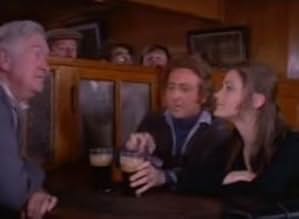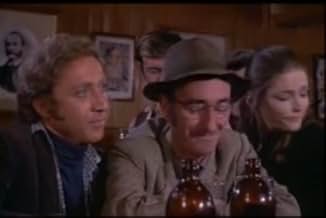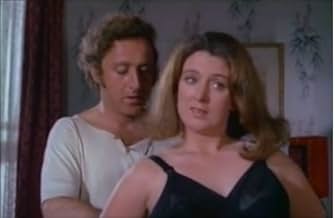In Dublin, a working class family has been unsuccessful in convincing their son to get a real job: the son prefers his job of scooping up horse's dung and selling it for flower gardens. An A... Read allIn Dublin, a working class family has been unsuccessful in convincing their son to get a real job: the son prefers his job of scooping up horse's dung and selling it for flower gardens. An American exchange student almost runs him over and gets to know him. The dung man has ignor... Read allIn Dublin, a working class family has been unsuccessful in convincing their son to get a real job: the son prefers his job of scooping up horse's dung and selling it for flower gardens. An American exchange student almost runs him over and gets to know him. The dung man has ignored warnings from his family and suddenly the horses have been banned from Dublin. His new ... Read all
- Awards
- 1 nomination
- Blacksmith
- (uncredited)
- Walter
- (uncredited)
- Policeman
- (uncredited)
- Man in the Pub
- (uncredited)
- Director
- Writer
- All cast & crew
- Production, box office & more at IMDbPro
Storyline
Did you know
- TriviaJean Renoir was considered to direct.
- GoofsEarly on in the film, Zazel tells Quackser that 'Dublin' comes from the Danish for 'black water', but the city's name is Irish in origin, not Scandinavian.
- Quotes
Quackser Fortune: You learnin' a lot at Trinity?
Zazel: Well, Dublin has a very rich history. For instance, did you know that Jonathan Swift wrote "Gulliver's Travels" here and that Handel's Messiah had its first premiere here.
Quackser Fortune: How much did they charge you for that?
- ConnectionsFeatured in WatchMojo: The Best Comedy Movies of All Time from A to Z (2020)
And then there's the basic premise of the film – Gene Wilder as a simple Dubliner who collects horse dung for a living. Not promising, on the face of it.
It's sometimes described as a romantic comedy. Well it's certainly very funny. And there's a romance at the heart of it. But thankfully, it comes from a time when films didn't all have to conform to rigid categories so it's also filled with a sweet sadness right from the start, characterised by the melancholy little tune which Quackser hums to himself. Its hero lives in straitened circumstances with poor prospects. But this is far from Angela's Ashes. On the contrary, Quackser's lack of ambition and easygoing approach to life are a cause for celebration at the end of the Sixties.
It's very unusual for its time in being a major Hollywood motion picture which was not only shot but set in contemporary Dublin. The steady-ish stream of big-budget films made here in those years such as The Blue Max, Darling Lili and The Spy Who Came in from The Cold were inevitably of another place and - often - another time. But here was our Dublin on the big screen, though admittedly a Dublin that was already fading away before our eyes.
It was filmed in August/September 1969 mainly on location around the city but also in Ardmore Studios. It opened in the USA in July 1970 but thanks to distribution problems, it didn't reach Irish cinemas until June 1972, which is when I first saw it.
Let me tell you a little about some of the people involved, all of whom have had extraordinary careers: Whatever about Quackser's improbable story, Gabriel Walsh, who wrote the screenplay, can easily match him. Born into poverty in Inchicore in 1938, one of 10 children, he found himself working as a waiter in the Shelbourne Hotel at the age of 16 when a chance meeting with the great diva, Margaret Bourke-Sheridan led to him being whisked off to a privileged life in the USA and a career as an actor and writer. All of this is recounted in his autobiography, Maggie's Breakfast which was published in 2012. Incidentally he claims that the "dung recycling" business was his own first job.
Waris Hussein, the Indian-born British director, who incidentally directed the first four episodes ever of Dr. Who, spent most of his career in television, directing only half a dozen feature films in the course of a very busy 40-year career. The distinguished cinematographer Gilbert "Gil" Taylor demonstrates here his affection for urban scruffiness, already shown on A Hard Day's Night and Ferry Cross The Mersey – a far cry from his most famous films, Dr. Strangelove and the original Star Wars.
This was Gene Wilder's fourth feature film. He had already notched up Bonnie & Clyde, The Producers and Start the Revolution Without Me. The following year would bring Willie Wonka and the Chocolate Factory. So he was already a hot, if odd, property. For 21-year old Margot Kidder it was only her second feature film. Indeed it seems that after some harsh words from Waris Hussein during the making of Quackser Fortune, she temporarily left films to study acting in New York, doing television work to pay her bills. But when the money ran out, she returned to Hollywood and of course, huge success as Lois Lane opposite Christopher Reeve in the Superman movies.
1969 must have been a fantastic summer for Irish actors as, for many of them, Ryan's Daughter had already begun its lengthy shoot in Kerry. And anybody who wasn't down there seems to have ended up in Quackser Fortune. So at times it's not so much a "Who's Who" as a "Who's That?" of Irish acting but among those familiar to Irish viewers are two singers - the balding basso, Charlie Byrne, Joe Lynch's sidekick on Living With Lynch as a blacksmith and the celebrated tenor Martin Crosbie as a guard, not to mention Glenroe's Robert Carrickford as a waiter and in particular the three bar-flies in The Gravediggers in Glasnevin – David Kelly as how to put this delicately a shoe-fetishist, the wonderful Danny Cummins as a very persistent pub pest and in sharp contrast to his role as Fr. Sheehy in The Riordans, the young Tony Doyle as a gold-medallioned Lothario. It's a delight to see Eileen Colgan in a role that would certainly raise the eyebrows of those who know her best from Glenroe and later from Fair City. And what can you say about Quackser's family especially the lovely Liz Davis as his bicycling sister and the magnificent Seamus Forde and May Ollis as the long-suffering Fortune parents. And spare a thought for poor Paul Murphy, later to be beloved as a Cork-Mother-of-Seven and Ballymagash town-councillor in Hall's Pictorial Weekly, but here the worst kind of Trinity College rotter called Damian.
Obviously one of the joys of the film for those of us familiar with Dublin, old and new, is to spot the changes that 40 plus years have wrought, especially around the north and south docks, though Trinity College and the area around the Peppercannister Church look remarkably unchanged. One surprisingly modern touch is the graffiti scrawled on a wall at one point: "Vote No" – a timeless sentiment!
- liffeystynx
- Feb 10, 2017
- Permalink
- How long is Quackser Fortune Has a Cousin in the Bronx?Powered by Alexa
Details
- Release date
- Country of origin
- Language
- Also known as
- Quackser Fortune hat 'nen Vetter in der Bronx
- Filming locations
- Ha'penny Bridge, Dublin, County Dublin, Ireland(on location)
- Production company
- See more company credits at IMDbPro
Box office
- Gross US & Canada
- $140,985
- Runtime1 hour 30 minutes
- Sound mix
- Aspect ratio
- 1.66 : 1
Contribute to this page


























